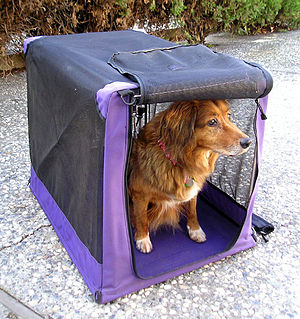 |
| English: dog in a soft crate Taken by Elf (Photo credit: Wikipedia) |
Unless your puppy is instinctively perfectly obedient, read
on for some tips to help you and your puppy work together to achieve positive
results. The puppy obedience training ideas below will ensure your puppy is trained in no time.
Make sure your puppy has gotten its shots. Check your puppy's
health if you notice him having a hard time with training. Puppies are good at
hiding their pain. Changes in behavior may be the only sign of a health
problem. For instance, aggression could be a mask for pain.
Always discourage any bad behavior you see. Use a firm voice
when saying "no." Never scream and never use an object or your hand
to strike your puppy. Vocally rebuke your puppy as soon as possible. Puppys do
not remember things for too long. If you wait too long, the puppy won't
understand what you're trying to tell it.
Has your puppy been tugging the leash? This is a common
complaint that owners have with their puppys and it's simple to fix. Go to the
pet store in your town and get a harness so that you can walk with greater
ease.
One thing to remember when puppy training is that all your
actions are molding its behavior and personality. You don't want to undo
training you're worked hard on, so watch what you do at all times. Always work
towards desired behaviors to mold them properly.
For each time you use your pets name in a negative way, such
as a reprimand, make an effort to use it positively 2 or 3 times. Your canine
friend needs to know that his name is a good thing, as he should always feel
safe coming to you when his name is called out.
"Leave it" is an important command to teach,
starting when you bring your puppy home. Teaching them to "leave it"
will stop them from destructive chewing and coming in contact with something
that could potentially hurt them.
You should not let your puppy drag you when you are walking
him or her. You are the one in control. Get a decent training collar with a
shorter leash to start obedience training, and make them heel when they go
through gates, doors and walk with you. Keep in mind that you are in charge!
If you have to give your puppy a verbal correction, be sure
that they are sharp, to the point, and short. Don't drag on and rant how your puppy
is bad. Just tell them no, and redirect them to the task you are asking them to
do. Also make sure that the volume of your voice commands their attention and
lets them know that you mean business.
When leash-training your puppy, keep some slack in the
leash. Puppys want to see what's going on around them at all times. This
eagerness can cause them to pull against the leash if it's held too tightly.
Teach your puppy to relax and let them get used to walking along on a slack
leash.
Puppies need to learn to socialize early in life. He needs to
learn how to behave around both humans and other puppies. This is best taught early.
This will help in reducing sporadic behavior when it comes to new environments,
also.
Consistency is the key to training. If there is more than
one person training your puppy, you need to make sure all the members of your
household are using the same rewards and commands. It will be easier for the puppy
if he or she learns only one particular command set and becomes accustomed to
the response the behavior receives.
Consistency is critical for crate training to succeed.
Always give the pup the option to go to the bathroom after leaving his crate.
With time, your puppy will wait for the right tine to relieve himself.
You have to have patience when you are training your puppy.
This will make it less likely that you or your puppy will become frustrated or
upset with the process of training. It takes time for your puppy to learn what
is expected from him. Understand that your puppy wants your approval and is
doing his best to earn it.
Stay away from training devices such as shock collars. They
often do not function well as they say they do and are a lot more expensive as
opposed to conventional methods of training. They can also discourage good
behaviors as they inhibit your puppy's behavior too much. Generally speaking,
these techniques often produce undesirable results.
Establish feeding habits for your puppy. Make sure that they
know when a meal is coming, so that they can get into a set routine. This will
set a quality schedule for your puppy so that they are ready for all meals.
Even your disobedient puppy can be trained. With time and
patience, all puppies can learn proper behavior. Utilize the tips learned here
to reduce the hardship related to training your pet while maximizing results
also.

Really awesome post, Thanks for sharing information about puppy obedience training.
ReplyDeleteDoggonit Obedience